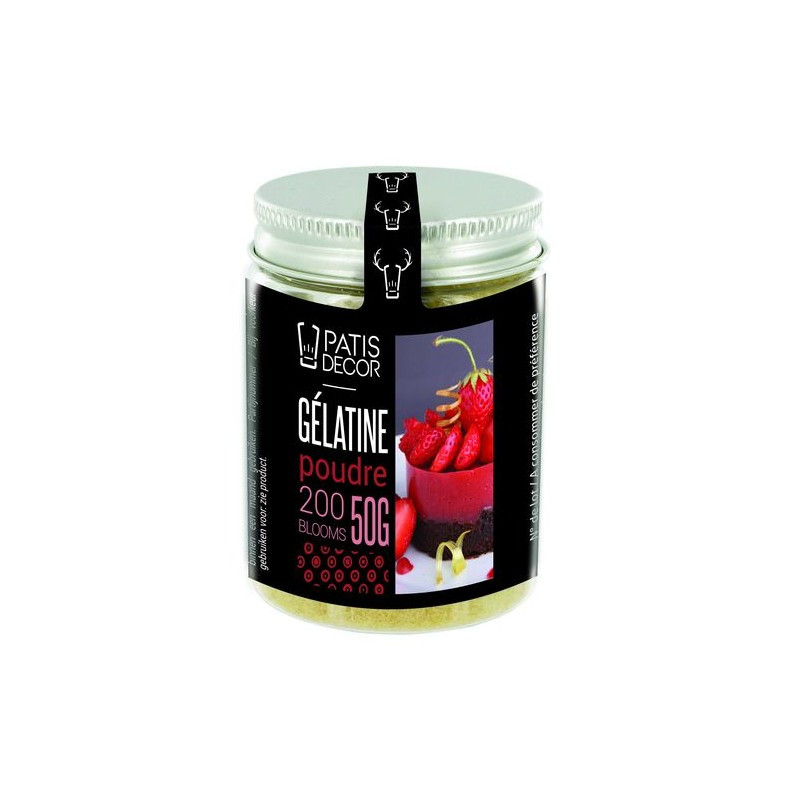

Order by 4 pm = delivery the next working day.
From CHF 100 purchase


Delicious cakes, sweet desserts and noble glazes get their stability from gelatine. This gelatine, which is produced exclusively from bovine hides in the form of a powder, is mixed with water beforehand and heated in the microwave until it is completely dissolved. Afterwards it can be processed like any other gelatine. This way you achieve optimal results for all treats with gelatine.
Data sheet
Gelatine is an indispensable helper when it comes to making creams, fillings and icings. With the right dosage and application, soft masses are created with sufficient stability to retain their shape in a cake, for example. Fruit jellies or even gummy bears can also be made with gelatine.
Beef gelatin is the ideal substitute for those who want to avoid conventional gelatin. Standard gelatin is pork gelatin and many people abstain from eating pork products due to their religion, beliefs and other reasons. Accordingly, bovine gelatin offers the perfect substitute, as it is in no way inferior to pork gelatin in terms of functionality and efficiency.
Since it is of animal origin, it is sometimes replaced by vegetable gelling agents, but caution is advised in some recipes. Find out in advance about the melting or gelling point and the duration of the effect. Glazes in particular should be made with gelatin. At 25 to 35 °C, its solidification point is rather low, so the coated cake or dessert will not be melted by the glaze. With vegetable gelling agents, the glaze cannot cool as long and must be used immediately, which can lead to visual losses. In addition, the effect of some vegetable agents wears off after a few hours; in the worst case, this could lead to the collapse of the cake.
To prevent lumps from forming in the cake filling or the cream, you should know the correct way to handle gelatin. This is because it must always be adjusted and cannot simply be added to the cold cream. Prepare the cream in advance according to the recipe, often whipped cream is folded into the mass only after levelling.
In direct comparison, one sheet of gelatin is approximately equal to ½ teaspoon of powder, which is about 2.5 g. Mix the desired amount of gelatin powder with 12.5 g of water per 2.5 g of gelatin powder. The amount of gelatin powder needed may vary, of course, depending on other ingredients and ambient temperature, as well as the texture you want to achieve. Heat the gelatin-water mixture in the microwave until the gelatin is completely dissolved. If the gelatin is heated too much and begins to boil, it will lose its binding properties.
Once the gelatin has melted, pour a large dollop of your cream mixture into the pan and mix well with the gelatin. Then pour this mixture right back into the rest of the cream and stir it in well. This process is called equalizing, this is how you prevent gelatin pieces from forming in your pie fillings and creams.
| Energiewert in kJ | 1488 kJ |
| Energiewert in kcal | 356 kcal |
| Fett | 0.00 g |
| davon gesättigte Fettsäuren | 0.00 g |
| Protein/ Eiweiss | 89.00 g |
| Salz | 0.25 g |
| Kohlenhydrate | 0.00 g |
| davon Zucker | 0.00 g |
Allergens

Delicious cakes, sweet desserts and noble glazes get their stability from gelatine. This gelatine, which is produced exclusively from bovine hides in the form of a powder, is mixed with water beforehand and heated in the microwave until it is completely dissolved. Afterwards it can be processed like any other gelatine. This way you achieve optimal results for all treats with gelatine.